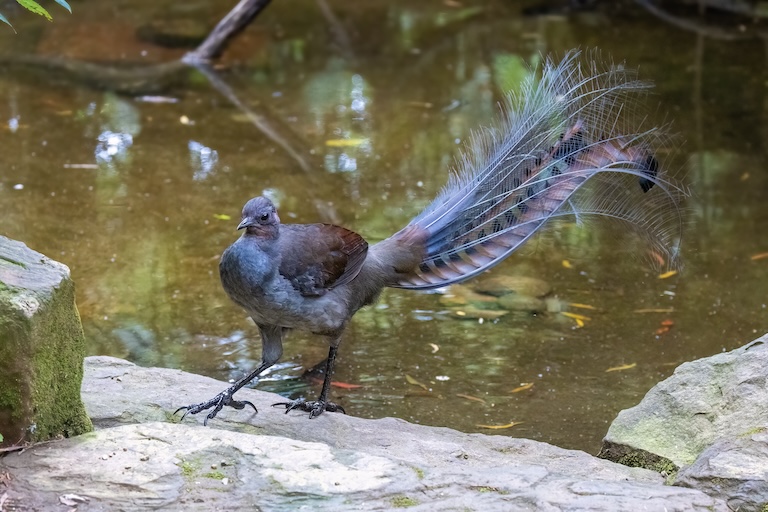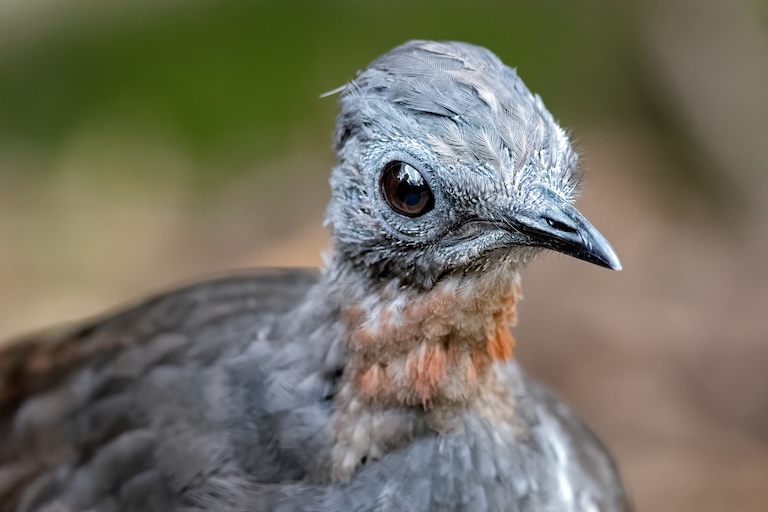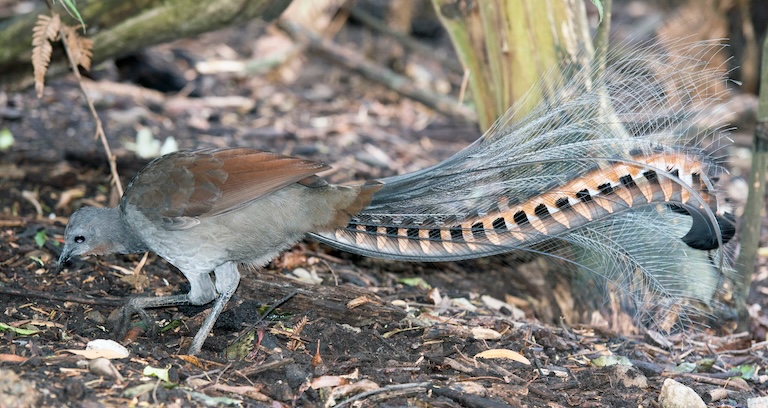Lyrebird Profile
What appears to be the cross between a pigeon and a peacock, the lyrebird is a fascinating and beautiful type of songbird native to Australia.
There are two different extant, or living, species still found on the continent today, although their habitats are widely dispersed and not always overlapping.
Typically, the lyrebird is carnivorous. You’ll find them eating a variety of invertebrates, ranging from beetles and other insects to spiders to earthworms. However, their diet is actually much more diverse than that! They have also been known to eat small amphibians and reptiles as well as seeds.

Lyrebird Facts Overview
| Habitat: | Bushlands and forests |
| Location: | Australia |
| Lifespan: | Up to 20 years |
| Size: | 80 to 100 centimeters tall (including tail); 76 to 79 centimeters wingspan |
| Weight: | Up to 930 grams |
| Color: | Brown, grey, white |
| Diet: | Insects, spiders, earthworms, small reptiles, small amphibians, seeds |
| Predators: | Foxes, larger birds, snakes |
| Top Speed: | 14 kilometers per hour |
| No. of Species: | 2 |
| Conservation Status: | Vulnerable |
In previous years, the lyrebird was viewed as plentiful in Australia. However, in the past two decades, bushfires and other natural disasters have posed quite a threat to these populations.
Once seen as a species of least concern, many organizations now view the lyrebird species as vulnerable.
You can identify a lyrebird by its impressive tails. Males have around 8 ornate feathers that feature beautiful, neutral designs. As you’ll learn later on, these are used for their courtship displays.
Interesting Lyrebird Facts
1. They can mimic sounds
One of the most amazing lyrebird facts is their ability to mimic sounds.
Mimicry is not uncommon in the animal world. You may have heard parrots or other animals mimic sounds before. However, the lyrebird’s repertoire of sounds is one of the most impressive out there! They’ve been known to mimic other animals, humans, and even machinery sounds.
2. There are two different species
There are two different species of lyrebird in the world. The first is the superb lyrebird. This species is larger than the second species, Albert’s lyrebird. Both species are found to be native only to Australia, as is typical for lyrebirds past and present.
3. They are some of the world’s largest songbirds
Typically, when you think of a songbird, you might thing of the small birds you can watch around your bird feeder. However, as passerines, lyrebirds are also classified as songbirds, and they’re some of the largest around!
An adult superb lyrebird can grow to be up to 100 centimeters long, with its tails making up nearly half its size.
4. We didn’t know how to classify them at first
When it first came to classifying the lyrebird, we didn’t know much about them. Due to their size and shape, we thought they are Galliformes like pheasants first. However, as time passed by, we were able to properly classify them, giving them their current scientific name.
If you look at the Aboriginal languages of Australia, the superb lyrebird is also known as weringerong, woorail, and bulln-bulln. 1
5. They’re one of the most notable songbirds in Australia
There are few songbirds as well known as the lyrebird in Australia. In fact, outside of kangaroos and koalas, lyrebirds are one of Australia’s most well-known animals!
The lyrebird is an important part of the culture in Australia. This is especially true in New South Wales, Victoria, and Queensland where the species are most common. Here, and throughout the rest of the continent, you can find many logos, emblems, and symbols depicting these beautiful birds!

6. Lyrebirds have a courtship dance
Those large, ornate tails aren’t just for looks! Like many species of birds, the lyrebird actually has a courtship dance to help them find the right mate. This involves males showcasing their tails.
Dancing isn’t the only part of this courtship display, however. When they’re trying to woo a female, male lyrebirds will also rely on their impressive vocal abilities. Between their dancing, feathers, and song, it’s safe to say that the lyrebird has romance down to a T!
7. They’re poor fliers
Although they have relatively large wingspans, the lyrebird isn’t built for flying. Instead, they’re ground birds. This means that they spend their time on the ground, rooting through the leaves and bush for their next meal.
8. Lyrebirds are shy
Although they may appear to be boastful thanks to their courtship dances, lyrebirds are actually quite shy. They’ll run easily, and it took some time for us to be able to learn about them.
Despite this, however, you’ll be surprised to learn that they’ve actually taken shelter with people before when trying to escape from bushfires!
9. They’re ancient!
When you think about ancient animals, you probably think about dinosaurs or aquatic reptiles like the plesiosaurus. However, as it turns out, ancient animals are a lot more familiar than that! In fact, lyrebirds are considered to be ancient animals.
Earlier, we mentioned that there are only two different species of the lyrebird. However, this is only living species. There is actually a third, prehistoric species of the lyrebird: Menura tyawanoides.
If you were to ever visit the Australian Museum, you’d actually be able to see the fossils they have on display there!2

Lyrebird Fact-File Summary
Scientific Classification
| Kingdom: | Animalia |
| Phylum: | Chordata |
| Class: | Aves |
| Order: | Passeriformes |
| Family: | Menuridae |
| Genus: | Menura |
| Species: | M. novaehollandiae M. alberti |
Fact Sources & References
- “Waa and Bulln Bulln Corroboree (Springvale Ceremonial Fire Pit)”, Greater Dandenong.
- “Menura tyawanoides”, Fossil Works.
